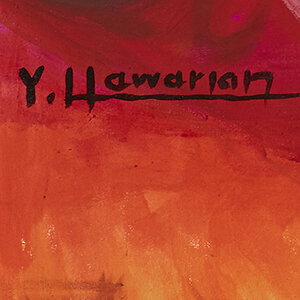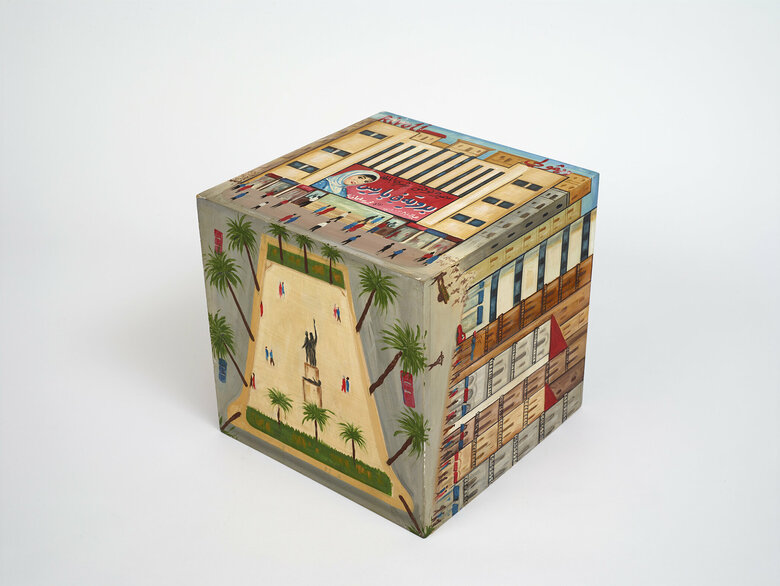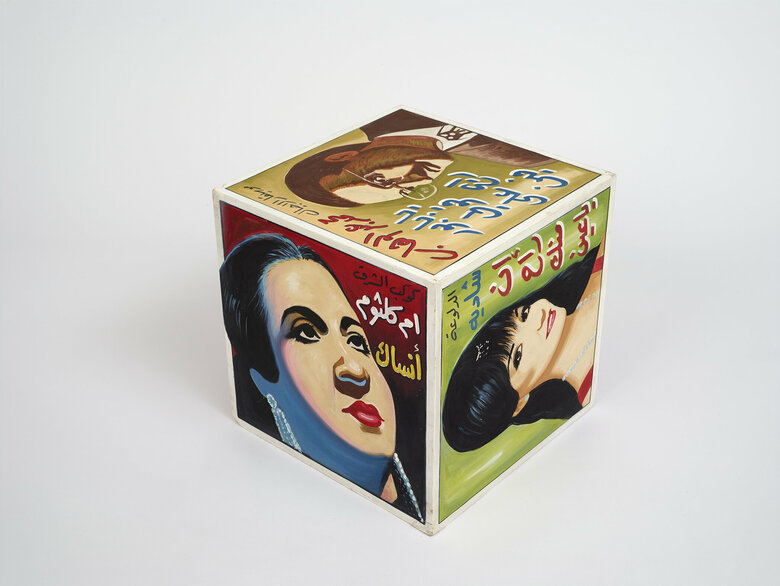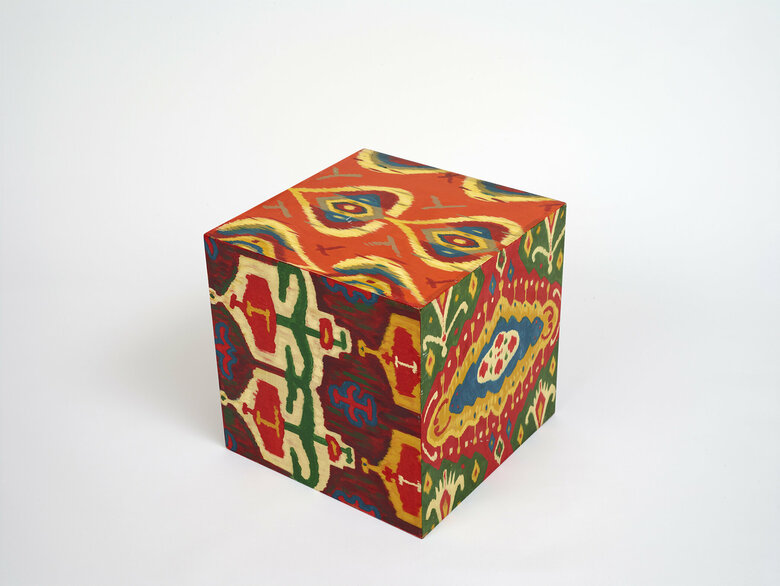Yervant Hawarian is a Lebanese artist of Syrian-Armenian descent. He was born on October 25, 1949, in the northern Syrian city of Qamishli. His grandfather was a survivor of the Armenian genocide...
-Yervant-Hawarian-Front-FW.jpg)
-Yervant-Hawarian-Front-FW.jpg)



Yervant Hawarian is a Lebanese artist of Syrian-Armenian descent. He was born on October 25, 1949, in the northern Syrian city of Qamishli. His grandfather was a survivor of the Armenian genocide...
Yervant Hawarian is a Lebanese artist of Syrian-Armenian descent. He was born on October 25, 1949, in the northern Syrian city of Qamishli. His grandfather was a survivor of the Armenian genocide who had established a successful flour mill in Qamishli, later inherited by Hawarian's father, Kevork. Yervant began drawing as a child and apprenticed with a local affiche artist known as Avedis, who was renowned for painting movie posters. The young Hawarian would soon follow a similar path.
However, the family’s fortunes changed when their business was nationalized under the economic reforms of the Abdel Nasser era of the United Arab Republic. This forced them to flee to Lebanon. Settling in the Armenian district of Bourj Hammoud, the family opened a shoe factory. Despite his early artistic ambitions, the Hawarian family saw a very different future for the young Yervant. Kevork expected his children to work in the factory to help support the family. Therefore, when confronted with his son’s artistic ambitions, Kevork responded with disapproval. This pushed the young artist to leave the family home at just fifteen years old, determined to forge a path as an artist.
Hawarian found shelter and opportunity in the world of cinema. His first major commission came from Cinema Madonna in Bourj Hammoud, in 1964. In lieu of payment, he was allowed to sleep at the theatre. Soon, his work attracted attention from neighbouring cinemas. By 1966, he was painting for theatres all across Bourj Hammoud including Knar, Salome, and Azar, later expanding to Plaza, Arizona, Royal, and Kermanik. His local reputation soared, prompting his family to welcome him back, feeling proud now that the name “Hawarian” had earned public admiration.
The late 1960s and early 1970s saw Hawarian’s steady expansion into Beirut, Tripoli, and other cities across Lebanon. His first commission in the capital was for Cinema Rivoli in 1966, where he painted a towering 14-meter image of a child for the film The Child of Sin. As his operation grew, the artist opened a downtown studio near Damascus Street and ran a larger workshop within Cinema Royal in Bourj Hammoud. At its peak, his studio employed over fifteen assistants who prepared canvases, stretched fabric, and applied base colors.
Hawarian’s visual style is instantly recognizable: he combines boldly colored flat backgrounds with strong tonal contrasts and figurative renderings that balance realism with slight cartoonish exaggeration. His characters often appear theatrically lit or icon-like, with expressive features and dynamic poses that reflect his roots in cinema and hand-painted advertising. Whether working on massive murals, film posters, or small-scale objects, Hawarian maintains a painterly precision that evokes both popular memory and graphic immediacy.
Building on his growing success in the film industry, Hawarian expanded into cinema operations in 1971, acquiring and managing Cinema Royal and later expanding to operate four other cinemas, including one in Tripoli. His dual role as poster artist and cinema owner positioned him uniquely in the industry, drawing admiration from both film distributors and fellow operators.
In tandem with his work in cinema, the artist also received commissions from major Lebanese political figures, beginning with Adnan Al Hakim in 1966 and Camille Chamoun in 1970. Across the decades, he became the official painter for five consecutive Lebanese presidents – Elias Sarkis, Bashir Gemayel, Amine Gemayel, Elias Hrawi, and Emile Lahoud. His works included everything from standard portraiture to panels that the state or political parties sponsored. This continued into the 1990s and 2000s, with portraits of figures such as Nabih Berri and Rafic Hariri, both influential political figures at the time.
In 1992, Hawarian's political commissions extended to Syria, when Lebanese President Elias Hrawi introduced him to Hafez Al-Assad. This led to over a decade of commissions from the Assad family, including portraits of Basel, Bashar, and Maher Al-Assad. His most monumental Syrian work was a 45-meter-high panel of Hafez Al-Assad with outstretched arms.
In the 2000s, he began taking on other kinds of commissions. Hawarian made murals for several churches around Lebanon. Most significantly, he produced the mural at the Armenian Catholic Cathedral of Saint Elias and Saint Gregory the Illuminator in Saifi Village, painted in 2005. He painted images of Jesus Christ as well as saints Elias and Gregory the Illuminator onto the wall of the church. He did so in his signature style characterized by flat, boldly colored backgrounds, strong contrasts, and figures rendered with a blend of realism and subtly cartoonish exaggeration.
In the 2010s, Hawarian was invited by L’Orient 961, a company that produces memorabilia objects, to create a series of acrylic works. This series took the form of hand-painted wooden boxes that reimagined his original movie posters—many of which had been lost, destroyed, or obscured by newer advertisements. Rendered in vivid acrylics and Hawarian’s signature style of flat color planes, bold contrast, and expressive figures, the boxes presented nostalgic yet contemporary homages to Arab cinema and pop culture. Several works featured icons such as Umm Kulthum and Abdel Wahab, depicted in Giants of Egypt, 2012, which is part of the Ramzi and Saeda Dalloul Art Foundation’s (DAF) collection. Others introduced entirely new compositions, such as Carpets, 2012, inspired by Persian ornamental motifs, and Burj Square, 2012, a vibrant, stylized depiction of Martyrs' Square in Beirut. The series as a whole bridged past and present, blending archival memory with playful reinterpretation in compact, collectible form.
In 2023, the artist began working on a series of movie posters in the style he had produced earlier in his career. These included acrylic works for films he had already made posters for, such as Doctor Zhivago, 2023, a poster for the 1965 film, as well as posters for films he simply felt a close connection to in his youth and were released before his career began, like Gone with the Wind, 2023, and Casablanca, 2023. All three pieces are part of DAF’s collection. Some works drew heavily from their original American posters, while others, like his piece for Casablanca, bore no resemblance to Western versions. In this composition, Hawarian places a romantic close-up of Humphrey Bogart and Ingrid Bergman at the center, their softened expressions framed by a bold scalloped motif in ochre, black, turquoise, and white that evokes the haloed forms of religious iconography. To the left, a bust of Paul Henreid is rendered in cool monochrome, visually secondary to the glowing central figures. The title “Casablanca” appears in thick, hand-lettered black and ochre text at the bottom, while the actors’ names are painted in red above. Hawarian often adapted facial features and body language to match the aesthetic preferences of Lebanese audiences, including “Arabizing” attributes such as Bogart’s widened nose to make the imagery more familiar and emotionally resonant.
Throughout his career, Hawarian also painted promotional portraits and banners for a number of iconic singers and actors, including Abdel Halim Hafez, Sabah, Umm Kulthum, Fairuz, and Adel Imam. His hand-painted works played a significant role in the marketing of both films and concerts during the pre-digital era in the Arab world.
Today, Hawarian lives and works in Beirut, Lebanon, surrounded by his family. He is currently working on a series of paintings about Beirut during his youth in the mid-20th century.
Edited by Elsie Labban
Notes
1Liam Sibai, interview with Garo Bardakjian, July 8, 2025, Ramzi and Saeda Dalloul Art Foundation, unpublished interview.
2 Political Figures, internal document, Ramzi and Saeda Dalloul Art Foundation, n.d.
3 Icons & Churches, internal document, Ramzi and Saeda Dalloul Art Foundation, n.d.
4 Nour Farra-Haddad, “Beirut’s Armenian Catholic Cathedral of Saint Elias and Saint Gregory the Illuminator,” Lebanon Traveler, October 8, 2020, https://www.lebanontraveler.com/en/magazine/saint-elias-and-saint-gregory-the-illuminator/.
5“Persian rug,” Cambridge Dictionary, accessed July 12, 2025, https://dictionary.cambridge.org/dictionary/english/persian-rug.
6 Doctor Zhivago, directed by David Lean (Beverly Hills, CA: Metro-Goldwyn-Mayer, 1965), film.
7 Gone with the Wind, directed by Victor Fleming (Beverly Hills, CA: Metro-Goldwyn-Mayer, 1939), film.
8 Casablanca, directed by Michael Curtiz (Burbank, CA: Warner Bros., 1942), film.
9“Arab Nose Shapes: A True Ethnic Symbol of Cultural Heritage,” Ethnic Rhinoplasty, accessed July 12, 2025, https://ethnic-rhinoplasty.com/arab-nose-shapes/.
Sources
Cambridge Dictionary. “Persian rug.” Accessed July 12, 2025. https://dictionary.cambridge.org/dictionary/english/persian-rug.
Curtiz, Michael, dir. Casablanca. Burbank, CA: Warner Bros., 1942.
Ethnic Rhinoplasty. “Arab Nose Shapes: A True Ethnic Symbol of Cultural Heritage.” Accessed July 12, 2025. https://ethnic-rhinoplasty.com/arab-nose-shapes/.
Farra-Haddad, Nour. “Beirut’s Armenian Catholic Cathedral of Saint Elias and Saint Gregory the Illuminator.” Lebanon Traveler, October 8, 2020. https://www.lebanontraveler.com/en/magazine/saint-elias-and-saint-gregory-the-illuminator/.
Fleming, Victor, dir. Gone with the Wind. Beverly Hills, CA: Metro-Goldwyn-Mayer, 1939.
Lean, David, dir. Doctor Zhivago. Beverly Hills, CA: Metro-Goldwyn-Mayer, 1965.
Ramzi and Saeda Dalloul Art Foundation. Icons & Churches. Internal document. n.d.
Ramzi and Saeda Dalloul Art Foundation. Political Figures. Internal document. n.d.
Sibai, Liam. Interview with Garo Bardakjian. July 8, 2025. Ramzi and Saeda Dalloul Art Foundation. Unpublished.
Selected Group Exhibitions
For the Children of Gaza, Msheireb Museums, Doha, Qatar
Public Artworks
2011 Mural for Saidat Al Bshara Church, Baabda, Lebanon
2010 Mural for Mar Elias Church, Mount Lebanon, Lebanon
2008 Mural for Kniset Al Sayide Church, Beirut, Lebanon
Mural for Sultanet Al Malayiki Church, Beirut, Lebanon
2007 Mural for Saidat Al Naher Church, Beirut, Lebanon
2005 Mural for Armenian Catholic Cathedral of Saint Elias and Saint Gregory the Illuminator, Beirut, Lebanon
2000 Poster of Rafic Hariri, Multiple Locations in Lebanon
1996 Poster of Nabih Berri, Beirut, Lebanon
1990 Poster of Kamal Jumblatt, Aley, Lebanon
1982 Posters of Amine Gemayel, Multiple Locations in Lebanon
1979 Posters of Bashir Gemayel, Multiple Locations in Lebanon
1978 Posters of Pierre Gemayel, Beirut, Lebanon
1976 Poster of Camille Chamoun, Beirut, Lebanon
1992 Posters of Elias Hrawi, Multiple Locations in Lebanon
1976 Posters of Elias Sarkis, Baabda, Lebanon
1970 Posters of Suleiman Frangieh, Multiple Locations in Lebanon
1970 Posters of Ara Yerevanian, Tripoli, Lebanon
1966 Posters of Adnan al Hakim, Beirut, Lebanon
1966 Posters of Gamal Abdel Nasser, Beirut, Lebanon
Join us in our endless discovery of modern and contemporary Arab art
Get updates from DAF
Follow Artists
Save your favourite Artworks
Share your perspectives on Artworks
Be part of our community
It's Free!
We value your privacy
TermsCookiesPrivacy Policies
Get updates from DAF
Follow Artists
Save your favourite Artworks
Share your perspectives on Artworks
Be part of our community
It's Free!
We value your privacy
TermsCookiesPrivacy Policies
Get updates from DAF
Follow Artists
Save your favourite Artworks
Share your perspectives on Artworks
Be part of our community
It's Free!
We value your privacy
TermsCookiesPrivacy Policies
If you have entered your email to become a member of the Dalloul Art Foundation, please click the button below to confirm your email and agree to our Terms, Cookie & Privacy policies.
We value your privacy, see how
Get updates from DAF
Follow Artists
Save your favourite Artworks
Share your perspectives on Artworks
Be part of our community
It's Free!
We value your privacy
TermsCookiesPrivacy Policies
-Yervant-Hawarian-Front-FW.jpg)
-Yervant-Hawarian-Front-FW.jpg)
-Yervant-Hawarian-FW.jpg)
-Yervant-Hawarian-FW.jpg)





